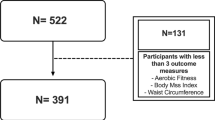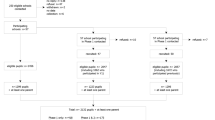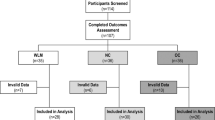Abstract
Intuition tells us that physical activity is central to weight reduction in obese children. Evidence, on the other hand, suggests that increases in physical activity are difficult to achieve in the short term, and may not be possible in the long term. One explanation could be an ‘activitystat’, a feedback loop in the child's brain that controls physical activity according to a set point. This brief article, which argues that it may not be possible to modulate the activity of children, reviews the principles of feedback control as they apply to physical activity, discusses evidence for its central control, and demonstrates how a physical activity control loop might operate to defend the set point. Studies restricted to objective measurement suggest that the physical activity of children varies in a systematic, rather than random manner. It varies little from environment to environment, from year to year or from place to place. Where children undertake more activity at one time of day, they appear to compensate at another. Systematic variation of this kind implies control, and the control of physical activity appears to lie with the child, not with his environment. Perturbation (temporary change in response to disturbance) during short-term physical activity interventions may be mistaken for modulation (permanent change in set point), a fundamentally different response. Perturbation lasts no longer than the disturbance that causes it, and there is little evidence that interventions raise activity long term, if at all.
This is a preview of subscription content, access via your institution
Access options
Subscribe to this journal
Receive 12 print issues and online access
$259.00 per year
only $21.58 per issue
Buy this article
- Purchase on Springer Link
- Instant access to full article PDF
Prices may be subject to local taxes which are calculated during checkout




Similar content being viewed by others
References
Warburton DE, Nicol CW, Bredin SS . Health benefits of physical activity: the evidence. Can Med Ass J 2006; 174: 801–809.
Armstrong N, Welsman J . Physiology of the child athlete. Lancet 2005; 366 (Suppl 1): S44–S45.
Metcalf BS, Voss LD, Hosking J, Jeffery AN, Wilkin TJ . Physical activity at the government-recommended level and obesity-related health outcomes: a longitudinal study (EarlyBird 37). Arch Dis Child 2008; 93: 772–777.
Harris KC, Kuramoto LK, Schulzer M, Retallack JE . Effect of school-based physical activity interventions on body mass index in children: a metaanalysis. Can Med Ass J 2009; 180: 719–726.
Wilkin TJ . Endocrine feedback control in health and disease. In: Bittar EE and Bittar N (eds). The Principles of Medical Biology. JAI Press Inc: Greenwich, CT, 1998, pp 1–28.
Joliffe N . The appestat; the appetite-regulating mechanism. Merck Rep 1952; 61: 3–7.
Uher R, Treasure J . Brain lesions and eating disorders. J Neurol Neurosurg Psych 2005; 76: 852–857.
Farooqi IS, O'Rahilly S . Leptin: a pivotal regulator of human energy homeostasis. Am J Clin Nutr 2009; 89: 980S–984S.
McAllister CJ, Whittington JE, Holland AJ . Development of the eating behaviour in Prader-Willi Syndrome: advances in our understanding. Int J Obes (Lond) 2010; 35 (2): 188–197.
Rowland TW . The biological basis of physical activity. Med Sci Sports Exerc 1998; 30: 392–399.
Wilkin TJ, Mallam KM, Metcalf BS, Jeffery AN, Voss LD . Variation in physical activity lies with the child, not his environment: evidence for an ‘activitystat’ in young children (EarlyBird 16). Int J Obesity (Lond) 2006; 30: 1050–1055.
Eisenmann JC, Wickel EE . The Biological basis of physical activity in children: revisited. Pediatr Exer Sci 2009; 21: 257–272.
Garland Jr T, Schutz H, Chappell MA, Keeney BK, Meek TH, Copes et al. The biological control of voluntary exercise, spontaneous physical activity and daily energy expenditure in relation to obesity: human and rodent perspectives. J Exp Biol 2011; 214 (Pt 2): 206–229.
Rowlands AV, Pilgrim EL, Eston RG . Patterns of habitual activity across weekdays and weekend days in 9-11-year-old children. Prev Med 2008; 46: 317–324.
McManus AM, W Chu EYW, Yu CCW, Hu Y . How children move: activity pattern Characteristics in lean and obese Chinese children. J Obesity 2011; 2011: 679328 online. doi: 10.1155/2011/679328.
Steele RM, van Sluijs EM, Sharp SJ, Landsbaugh JR, Ekelund U, Griffin SJ . An investigation of patterns of children's sedentary and vigorous physical activity throughout the week. Int J Behav Nutr Phys Act 2010; 7: 88.
Aznar S, Naylor PJ, Silva P, Pérez M, Angulo T, Laguna M et al. Patterns of physical activity in Spanish children: a descriptive pilot study. Child Care Health Dev 2011; 37: 322–328.
Wickel EE, Eisenmann JC, Pangrazi RP, Graser SV, Raustorp A, Tomson et al. Do children take the same number of steps every day? Am J Hum Biol 2007; 19: 537–543.
Mallam KM, Metcalf BS, Kirkby J, Voss LD, Wilkin TJ . Contribution of timetabled physical education to total physical activity in primary school children: cross sectional study. Brit Med J 2003; 327: 592–593.
Fremeaux AE, Mallam KM, Metcalf BS, Hosking J, Voss LD, Wilkin TJ . Physical education time in school and its influence on total physical activity: repeated measures study in 8-10 year-old children (EarlyBird 46). Int J Obesity (London); e-pub ahead of print 15 March 2011, doi:10.1038/ijo.2011.52.
Tou JCL, Wade CP . Determinants affecting physical activity levels in animal models. Exp Biol Med 2002; 227: 587–600.
Lightfoot JT, Turner MJ, Daves M, Vordermark A, Kleeberger SR . Genetic influence on daily wheel running activity level. Physiol Genomics 2004; 19: 270–276.
Leamy LJ, Pomp D, Lightfoot JT . An epistatic genetic basis for physical activity traits in mice. J Heredity 2008; 99: 639–646.
Mathes WF, Nehrenberg DL, Gordon R, Hua K, Garland Jr T, Pomp D . Dopaminergic dysregulation in mice selectively bred for excessive exercise or obesity. Behav Brain Res 2010; 210: 155–163.
Knab AM, Lightfoot JT . Does the difference between physically active and couch potato lie in the dopamine system? Int J Biol Sci 2010; 6: 133–150.
Kalra SP, Kalra PS . Neuroendocrine control of energy homeostasis: update on new insights. Prog Brain Res 2010; 181: 17–33.
Redman LM, Heilbronn LK, Martin CK, de Jonge L, Williamson DA, Delany DP et al. Metabolic and behavioral compensations in response to caloric restriction: implications for the maintenance of weight loss. PLoS One 2009; 4: e4377.
Martin CK, Heilbronn LK, de Jonge L, DeLanyJP, Volaufova J, Anton SD et al. Effect of calorie restriction on resting metabolic rate and spontaneous physical activity. Obesity 2007; 15: 2964–2973.
Ness AR, Leary SD, Mattocks C, Blair SN, Reilly JJ, Wells J et al. Objectively measured physical activity and fat mass in a large cohort of children. PLoS Med 2007; 4: e97.
Metcalf BS, Hosking J, Jeffery AN, Voss LD, Henley W, Wilkin TJ . Fatness leads to inactivity, but inactivity does not lead to fatness: a longitudinal study in children (EarlyBird 45) Arch Dis Child; e-pub ahead of print 23 June 2010, doi:10.1136/adc.2009.175927.
Pacy PJ, Webster J, Garrow JS . Exercise and obesity. Sports Med 1986; 3: 89–113.
Levine JA, McCrady SK, Lanningham-Foster LM, Kane PH, Foster RC, Manohar CU . The role of free-living daily walking in human weight gain and obesity. Diabetes 2008; 57: 548–554.
Szendroedi J, Roden M . Mitochondrial fitness and insulin sensitivity in humans. Diabetologia 2008; 51: 2155–2167.
Keyser RE . Peripheral fatigue: high-energy phosphates and hydrogen ions. Phys Med Rehab 2010; 2: 347–358.
Acknowledgements
I am grateful to the EarlyBird team who have generated compelling and sometimes challenging observations over the years, and particularly to Brad Metcalf, MSc, who has spent long hours debating the physical activity data and their interpretation. I am similarly indebted to the people who generously fund the EarlyBird Study—currently the Bright Futures Trust, Nestec, Peninsula Medical School, Kirby Laing Foundation, League of Friends and the Earlybird Diabetes Trust.
Author information
Authors and Affiliations
Corresponding author
Ethics declarations
Competing interests
The author declares no conflict of interest.
Rights and permissions
About this article
Cite this article
Wilkin, T. Can we modulate physical activity in children?. Int J Obes 35, 1270–1276 (2011). https://doi.org/10.1038/ijo.2011.163
Received:
Revised:
Accepted:
Published:
Issue Date:
DOI: https://doi.org/10.1038/ijo.2011.163
Keywords
This article is cited by
-
Promoting Positive Health Outcomes in an Urban Community-Based Physical Activity Intervention for Preschool Aged Children on the Autism Spectrum
Journal of Autism and Developmental Disorders (2023)
-
Exploring activity compensation amongst youth and adults: a systematic review
International Journal of Behavioral Nutrition and Physical Activity (2022)
-
Children and adolescents do not compensate for physical activity but do compensate for sedentary behavior
German Journal of Exercise and Sport Research (2022)
-
Testing the activitystat hypothesis: a randomised controlled trial
BMC Public Health (2016)
-
A non-equivalent group pilot trial of a school-based physical activity and fitness intervention for 10–11 year old english children: born to move
BMC Public Health (2016)



